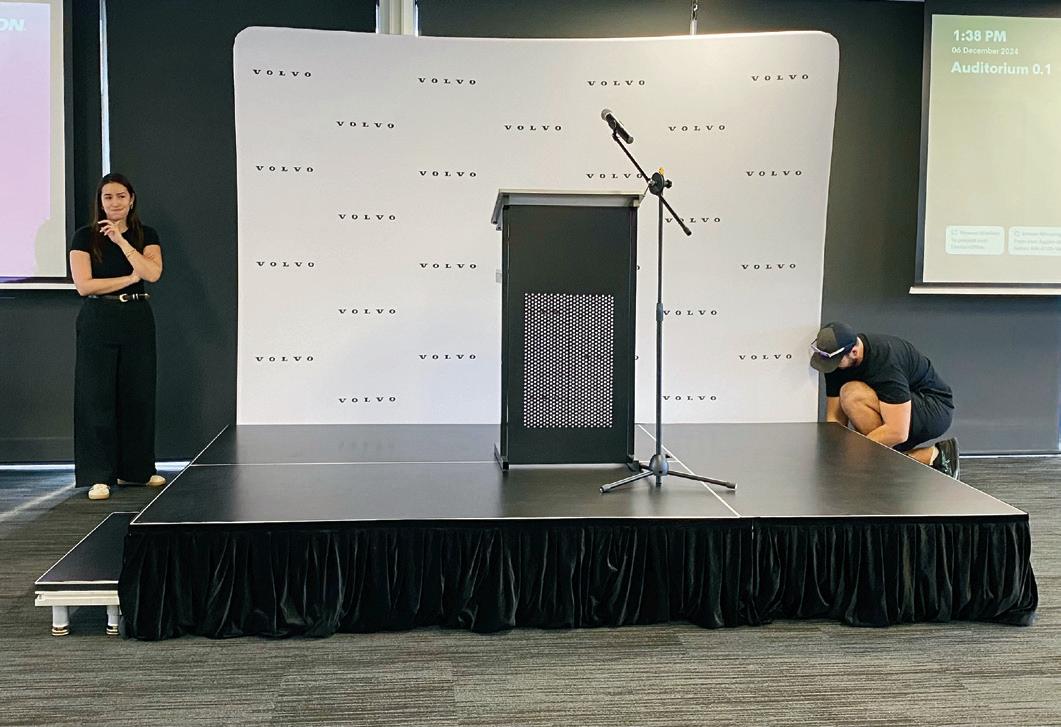
















The Classmate® range of bag & hat hooks, now five great designs and a wide range of colours to choose from. Suitable for installation indoors or out.

All New Stowmate® Aluminium BagTrac FS2400 designed specifically for use with your Safehook Ihook products. Stowmate offers End-Users and Specifiers a smarter, safer way to mount bag and hat hooks. Double sided, floor mounted storage.


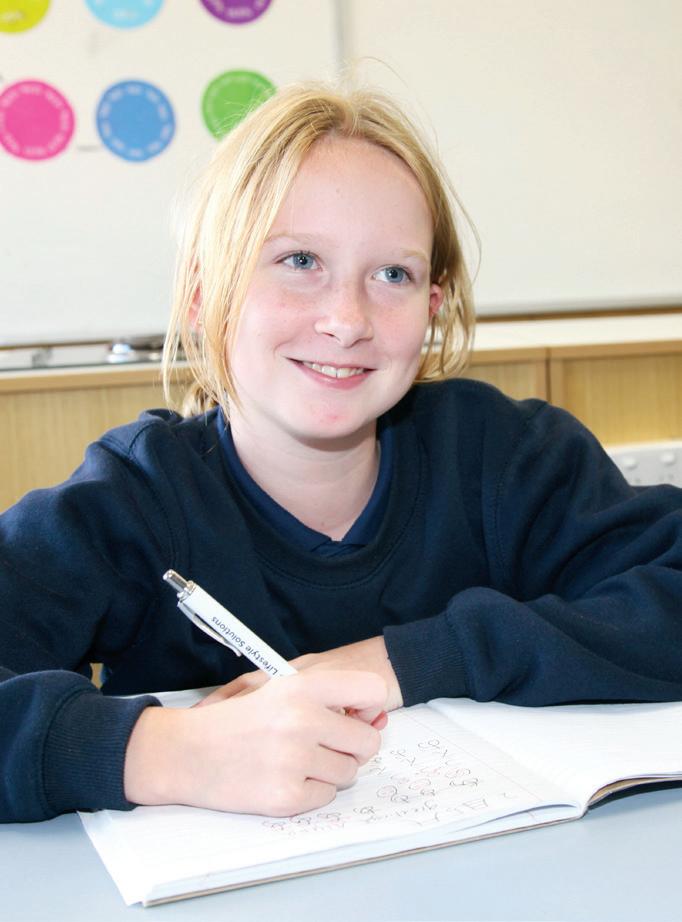



School News is distributed to primary, secondary and intermediate schools throughout Australia by Multimedia Pty Limited.
The views and images expressed in School News do not necessarily reflect the views of the publisher. The information contained in School News is intended to act as a guide only, the publisher, authors and editors expressly disclaim all liability for the results of action taken or not taken on the basis of information contained herein. We recommend professional advice is sought before making important business decisions.
The publisher reserves the right to refuse to publish or to republish without any explanation for such action. The publisher, its employees and agents will endeavour to place and reproduce advertisements as requested but takes no responsibility for omission, delay, error in transmission, production deficiency, alteration of misplacement. The advertiser must notify the publisher of any errors as soon as they appear, otherwise the publisher accepts no responsibility for republishing such advertisements. If advertising copy does not arrive by the copy deadline the publisher reserves the right to repeat existing material.
Any mention of a product, service or supplier in editorial is not indicative of any endorsement by the author, editor or publisher. Although the publisher, editor and authors do all they can to ensure accuracy in all editorial content, readers are advised to fact check for themselves, any opinion or statement made by a reporter, editor, columnist, contributor, interviewee, supplier or any other entity involved before making judgements or decisions based on the materials contained herein.
School News its publisher, editor and sta is not responsible for and does not accept liability for any damages, defamation or other consequences (including but not limited to revenue and/or profit loss) claimed to have occurred as the result of anything contained within this publication, to the extent permitted by law.
Advertisers and Advertising Agents warrant to the publisher that any advertising material placed is in no way an infringement of any copyright or other right and does not breach confidence, is not defamatory, libellous or unlawful, does not slander title, does not contain anything obscene or indecent and does not infringe the Consumer Guarantees Act or other laws, regulations or statutes. Moreover, advertisers or advertising agents agree to indemnify the publisher and its agents against any claims, demands, proceedings, damages, costs including legal costs or other costs or expenses properly incurred, penalties, judgements, occasioned to the publisher in consequence of any breach of the above warranties.
The Multimedia Pty Ltd team acknowledges Aboriginal and Torres Strait Islander peoples as the First Australians and Traditional Custodians of the lands upon which we gather, work, and publish. We want to pay our respects to Elders past, present, and future, who continue cultural, educational, and spiritual connections to Country.
© 2025 Multimedia Pty Ltd. It is an infringement of copyright to reproduce in any way all or part of this publication without the written consent of the publisher.
EDITOR

By Gemma Easton, Editor
As adults around Australia headed to the polls for the recent federal election, there was some hand wringing over the future of our democracy.
Reporting released by the Australian Curriculum, Assessment and Reporting Authority (ACARA) in February showed that students had recorded the lowest scores in civics since testing began. Students’ knowledge and understanding of Australia’s democracy, political system, and civic processes had all fallen.
Only 28 percent of Year 10 students met the proficient standard in 2024, down from 38 percent in 2019. ACARA said this declining trend in student performance was repeated in other recent international civics and citizenship assessments. Data was taken from results of the National Assessment Program sample Civics and Citizenship (NAP-CC) Report 2024.
Declining results, however, don’t mean that young people don’t care about politics or the legal system.
Alongside the NAP-CC, students in Year 6 and Year 10 completed a questionnaire about their attitudes and engagement with civics and citizenship. Both year levels expressed concerns about issues affecting Australia, including pollution, climate change, crime and racism. Students, especially in Year 6, expressed a high degree of trust in civic institutions but showed considerably less trust in the media or social media.

If students don’t understand how Australia’s government and legal systems work, how can they participate fully in democratic life?
Commenting on the report, ACARA CEO Stephen Gniel said: “Civics and Citizenship has always been a key part of the Australian Curriculum, including in the latest version.
“Encouragingly, this latest report shows that most students rate citizenship behaviours, such as learning about Australia’s history, as important. Therefore, it is vital that all young Australians get a strong grounding with civics education to feel engaged with social and political issues, so that they can make a valuable contribution as society’s future stewards.”
With GenZ and millennials combined now outnumbering baby boomers as the dominant voting bloc, the downward trend in civics and citizenship attainment has raised some important questions. If students don’t understand how Australia’s government and legal systems work, how can they participate fully in democratic life? And with the rise of social media as young people’s preferred source of news, how can we make sure the information they are receiving about current events is reliable and trustworthy?
If civics and citizenship education is to be improved, does it need to be done in the classroom, or should we be looking elsewhere?
Civics education has been included in the Australian Curriculum (v8.4) since its release in 2014, with the Revised Australian Curriculum: Civics and Citizenship, published in 2022. The aim of civics and citizenship education, as outlined by ACARA, is to “assist students to develop the civic knowledge, understanding and skills to enable them to engage purposefully as citizens at local, state, national, regional and global levels, now and in the future.”
However, while it is written into the curriculum, access to and delivery of civics and citizenship education is not equal for all students. There is no review or audit into each state or territory’s curriculums to ensure they include the minimum civics and citizenship content. This means key elements may not be covered in any explicit or compulsory way for many students.

Students’ opportunities for formal civics education can vary widely between different states and territories, in line with individual state curriculum, as well as between rural, regional, and different socio-economic areas.
The NAP-CC found that achievement in civics and citizenship gradually increased with increasing levels of parental education and parental occupation. This resulted in significant differences between the highest and lowest occupational and educational groups. The gap between Indigenous and non-Indigenous students attaining the proficient standard at both Year 6 and Year 10 was significant.
The Australian Curriculum introduces students to civics and citizenship in Year 3,
with topics and ideas covered increasing in complexity between Year 3 and Year 6. Key study areas include identity and diversity, and democracy and citizenship.
In Years 7 and 8, civics and citizenship education continues, however student access to civics and citizenship education in Years 9 and 10 is determined by individual schools. Some schools offer the subject as an elective, others include it as part of other humanities subjects, while some schools do not offer civics and citizenship education at all beyond Year 8.
The haphazard implementation of civics and citizenship education led to a Joint Standing Committee on Electoral

Matters inquiry into civics education and participation in Australia in March 2024.
Committee Chair, Senator the Hon Carol Brown said: “Australia’s system of compulsory voting means that all Australians need to be informed to participate in our democracy and elections. This is particularly important at a time where democracies around the world, including Australia, are facing rising disengagement, distrust, and misinformation and disinformation in a complex online information environment.
“The Committee heard clear evidence that the quality of formal civics education varies considerably between the states and territories, and even individual schools—which means that many young people are not getting the information they need to be informed and responsible citizens. It is clear that Australia needs a strengthened and standardised approach to civics and citizenship education.”
The Inquiry’s report, From Classroom to Community: Civics education and political participation in Australia, found that civics education in Australia is not working, and that Australians are struggling to participate fully in our democracy because of the fragmented and inequitable nature of civics education. The report highlighted several factors which impact the delivery of civics education, including limited time allocated for teaching and learning in a crowded curriculum; teacher knowledge, training, and time to deliver civics content; school resourcing; and flexibility in curriculums.




























By Sarah Corry, Principal, Henbury School, NT
After six intense years leading Henbury School, Principal Sarah Corry reflects on the personal and professional journey that led her to take much-needed long service leave. Using the metaphor of hiking Victoria’s Great Ocean Walk, she explores the challenges of leadership, the cost of carrying too much alone, and the power of pausing to regain perspective. This article offers a candid, heartfelt insight into leadership burnout, resilience, and the beauty of finding your way forward—one step at a time.
If you’ve ever hiked the Great Ocean Walk in Victoria, you’ll know it’s an experience of breathtaking beauty, physical challenge, and unexpected moments of sheer joy. It’s also an apt analogy for my first six years as Principal at Henbury School—an incredible journey of resilience, reflection, and reward.
Much like the ups and downs of that coastal trail, my time at Henbury has been marked by steep climbs, unexpected detours, and moments of quiet awe.
Henbury is a specialist school catering for young people from Year 7 to 12 in the northern suburbs of Darwin. One of only five standalone special schools in the Northern Territory, we are guided by our motto: ‘Preparing for Future Lifestyles.’ At the heart of everything we do is the aim to support our students in achieving individual autonomy and enabling their full participation in the economic, civic, and social life of the community.
Taking all of Term 1 this year as long service leave wasn’t a decision I made lightly. But continuing to push through was affecting my health, and I knew I wasn’t always showing up as the best leader I could be. The principal role never truly stops. I constantly argued with myself—justifying that it was better to turn up and keep going, even at the expense of who I was for my family. I found myself withdrawing from some friendships too, convinced I had nothing left to give—rather than taking the time I truly needed to reboot and return as both a successful leader and a present wife and mother. I felt a lot of guilt
about the pressure my absence placed on the team. But over the last six years, there never seemed to be a “right” time.
Walking for six days along the rugged southern coast gave me the kind of clarity I hadn’t realised I’d been craving. With no emails, no meetings, and no Outlook calendar marking the hours, I finally had the space to slow down and think—not just about school, but about life.
Each day on the trail offered its own lesson. Some tracks were smooth and shaded; others, steep and exposed. There were moments I felt strong and capable, and others where I questioned whether I could keep going. It was, in many ways, a mirror of my leadership journey—demanding, humbling, and unexpectedly beautiful.
I thought a lot about the students and staff at Henbury—about what we’ve built together and what still lies ahead. I reflected on the importance of leading with presence, not just persistence. And most of all, I realised that stepping away doesn’t mean stepping back. In fact, it was only by taking that step away that I could see the bigger picture more clearly.
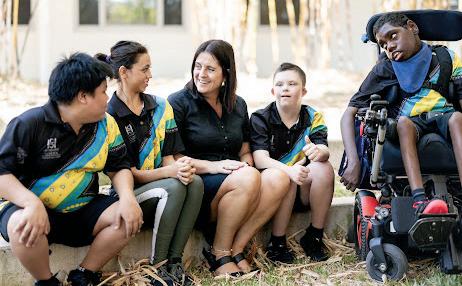

At the time, I didn’t recognise I was burnt, but I knew I needed help. I started seeing a psychologist every other Saturday for nine months, confronting limiting beliefs and reconnecting emotion with thought. I also started walking each day again—something I had neglected in the mistaken belief that I didn’t have time.
The crises didn’t stop. But I began to realise that leadership wasn’t about carrying everything myself; it was about building a team to walk beside me. I learned to delegate. I leaned into others’ strengths. I stopped trying to prove myself by doing it all.
We adjusted our pace to avoid burnout— on the trail, and at Henbury.
Day 4 brought a surprising gift: momentum.
Our bodies adjusted. Our packs felt lighter. I remember standing at the Aire River lookout, soaking in the beauty, sharing trail mix and Nurofen with my sister, laughing, and realising we had found our rhythm. We weren’t afraid to let each other know when we needed help to get through the day.
Year 4 at Henbury mirrored that sensation.
Our systems were stronger. Our team was cohesive. Trust was deeply rooted. We refined our whole-school literacy and numeracy programmes strengthened student voice through the NT Learning Commission, relaunched our major fundraising event—the Henbury Corporate Luncheon—relocated our café and op shop closer to school, and expanded vocational pathways for students.
I realised that things didn’t need to run through me to run well. Leadership wasn’t about control; it was about connection and trust.
I also carved out space to reflect beyond the immediate. Connections with the NT Principals’ Association, Casuarina Education Precinct leaders, and ASEPA gave me the support and perspective I needed.
Letting go of control and embracing vulnerability didn’t diminish me—it shaped me into a stronger leader.
By Day 5, the fatigue was harder to ignore. The magic was still there, but my ability to stay fully present had dulled.
Year 5 as Principal felt the same. Henbury was thriving. Our work training facility, Henbury Precinct, was thriving too, with the whole community rallying behind our students. This support helped more of them secure meaningful employment after school. We launched our Mini Woolies programme, saw dramatic improvements in student literacy, celebrated nearly a 100 percent NTCET graduation rate, and continued to strengthen our community partnerships.
I was even honoured with a 2024 Commonwealth Bank Teaching Award. Yet, as I sat between the Hon. Jason Clare and David Gonski at the ceremony in

Parliament House, Canberra, I felt numb— like a robot going through the motions.
I was wearing down.
There’s a certain kind of exhaustion that can’t be fixed with a weekend. I kept pushing it aside, telling myself I’d rest later. But in leadership, “later” rarely comes. By the end of that fifth year, Long Service Leave wasn’t a luxury—it was a necessity.
On Day 6—the final stretch—we weren’t racing anymore. Every ache had a story. Every step, a sense of accomplishment.
Year 6 felt the same. The urgency of the early days had given way to something steadier, more grounded. I felt immense pride in the community we had built— the leadership capacity, the culture of dignity and high expectations.
But I also knew it was time.
Taking long service leave wasn’t an escape—it was a decision rooted in strength, not weakness. I wasn’t walking away; I was stepping aside so I could return with clearer eyes and a fuller heart.
Sometimes, to really see how far you’ve come, you have to stop walking.
Stepping away gave me something I hadn’t realised I’d lost: stillness. In that stillness, I found not just rest, but perspective.
I remembered why I chose this work: the joy of seeing potential unlocked, the privilege of walking alongside young people, and the pride in leading a team that believes in every student’s right to a full and meaningful life.
The Great Ocean Walk didn’t just test my endurance—it restored my clarity.
I return to Henbury not with a new strategy or a big announcement, but with a deeper understanding of myself, my limits, and my purpose.
There were moments of doubt—questions about maintaining my rejuvenated self. So, I spent a Saturday morning at our café before returning to school. Watching our students work away gave me all the signs I needed.
When I stepped into Term 2, I was in awe.
Students entered with their individual quirks and magic, and staff connected instinctively to create a safe, inclusive learning space. Like a beehive, intricate and alive.
There are always more kilometres ahead. More challenges, more moments of joy, more steep climbs. But for now, I’m exactly where I need to be—on the path, boots laced, heart open.

By Gemma Easton , Editor
We often hear education leaders heralding that every student is different, or that no two students learn in the same way. This means meeting the needs of every student can be difficult within the traditional classroom framework.
To counter this, West Wallsend High School in New South Wales has introduced a dynamic range of learning and teaching options to make sure every student is catered for. With a combination of diff erentiation and extension, and a strong emphasis on personal achievement and wellbeing, every student is given a pathway to success.
Relieving Principal Michael Chandler explained. “We’re a low SES school, and our diverse learning programmes benefi t both staff and students. The focus is on promoting personalised growth, academic success, and wellbeing.”







Mr Chandler was a student of WWHS himself, starting at the school in 1988.
“We celebrate each student’s success, and this encourages a culture where eff ort and achievement are recognised. We want all students to feel proud of their goal sett ing and achievement, and to work to achieve their own personal learning goals, instead of comparing themselves to other students.”
WWHS actively pursues a culture of individual growth and success.
Rather than a one-size fi ts all teaching model, a variety of programmes and learning options are off ered.
“These programmes ensure that all students, regardless of their socioeconomic background, have access to tailored academic, emotional, and wellbeing support,” Mr Chandler said. The learning framework is for a holistic education, with success measured for each individual student. Good physical and mental wellbeing, as well as continual improvement, are as valued as academic results.
The learning programmes reflect the school motto, We Learn for Life. Mr Chandler said the motto reminds students that learning extends beyond the classroom and prepares them for success in all aspects of life. “The motto reinforces to students that education isn’t just about academic achievement, but about developing the skills, values, and mindset necessary to thrive in their future careers, relationships and communities.”
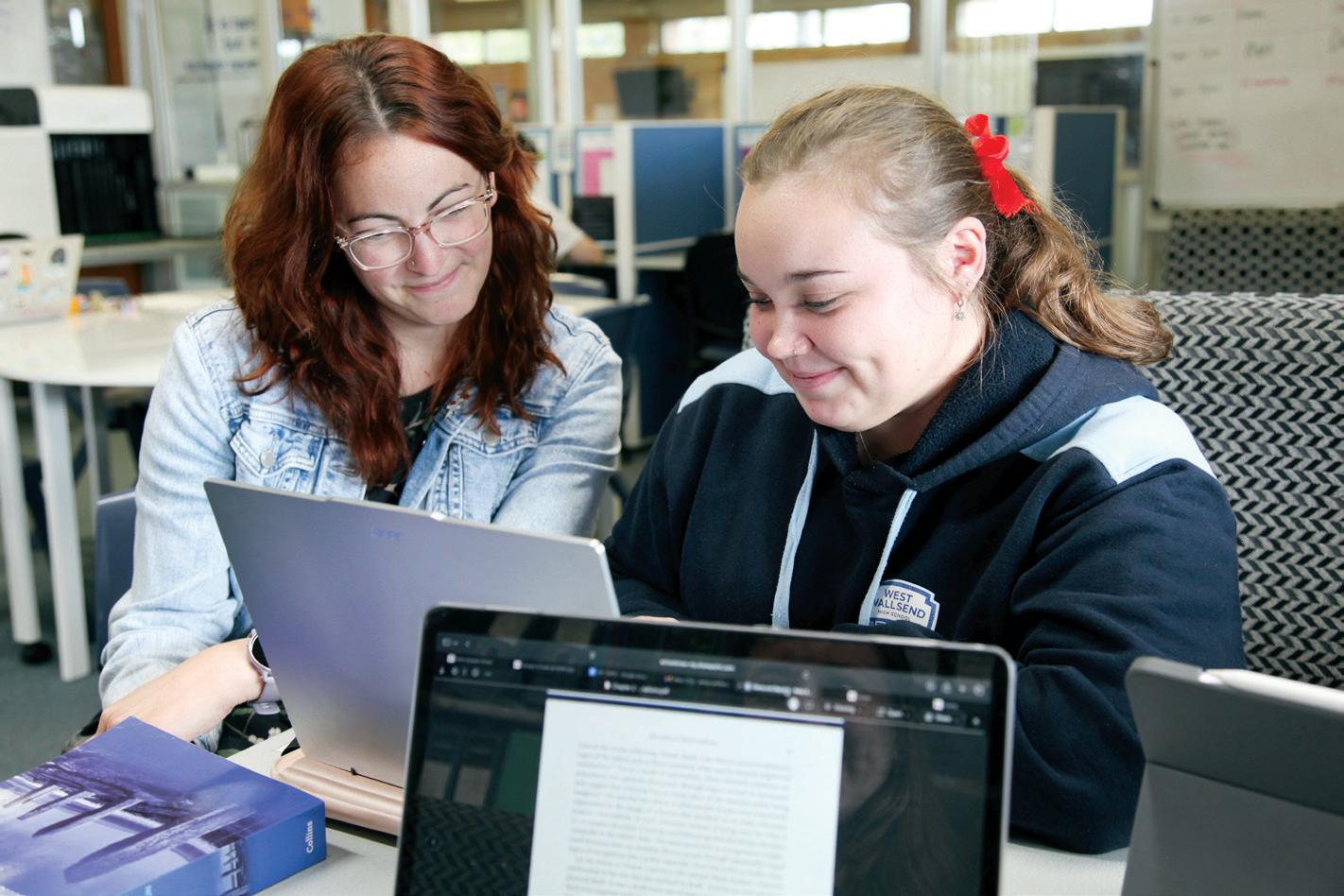
Three flagship programmes off ered at WWHS are SPARK, IGNITE and HORIZON. Each programme is designed to provide tailored support and foster student growth across various domains. “By focusing on personalised learning, wellbeing, and ongoing support, these programmes create an equitable learning environment that helps bridge gaps and empowers students to reach their full potential, regardless of their circumstances,” Mr Chandler said.
Part of the High Performance Gifted Education (HPGE) programme, SPARK nurtures individual talents across the four domains—academic, physical, creative and social-emotional—providing opportunities for personal growth and mentorship that may not be readily available outside of school.
Students in the SPARK programme receive personalised mentorship with tailored teaching practices to support learning and wellbeing needs, and customised learning experiences to foster success. SPARK students also receive individualised case management for personal and academic support throughout the year.
The HORIZON programme supports students in Year 7 and Year 8 for a smooth transition into high school. With a philosophy of “less faces and less spaces” and consistent teacher-student relationships, the programme helps to build strong relationships between students, teachers and parents.
“HORIZON helps students develop resilience, improve literacy and numeracy, and acquire strong organisational and self-regulation skills,” Mr Chandler said.
In their final year at WWHS, Year 12 students enter the IGNITE programme. IGNITE off ers resources and mentorship for Year 12 students, helping them overcome barriers to success, and preparing them for postschool opportunities. Each Year 12 student has an individual IGNITE profile, which is updated bi-weekly. The profile includes the student’s ultimate goal, mentor’s name and contact information, strengths and subjects of study, and regular progress updates on attendance and eff ort.
IGNITE profiles are not tucked away in a drawer and forgotten about as the year goes on.


We celebrate each student’s success, and this encourages a culture where effort and achievement are recognised
Rather, they are displayed prominently and regularly monitored. “Each Year 12 IGNITE profile is displayed in the principal’s office,” Mr Chandler said. “We use a traffic light system to track student progress.”
The success of each of these learning programmes relies on buy-in from staff, and the WWHS team is more than happy to get involved. “Our staff are deeply committed to helping students succeed. Many teachers are driven by a passion for making a tangible diff erence in students’ lives, and the opportunity to build strong, meaningful relationships with students, and witness their growth and success is highly rewarding.”
And since the introduction of the IGNITE programme, there has been plenty of success to celebrate. In 2019, before the introduction of the IGNITE programme, only 15 percent of WWHS students achieved university matriculation. By 2024, that number had risen to 57 percent, demonstrating a significant improvement in university entry rates. To further support its graduates, the school has implemented a student scholarship application process.
“In 2024, our students secured over $200,000 in scholarships, including notable awards such as the University of Newcastle Ma and Morley Scholarship ($60,000), which we have successfully won for three consecutive years,” Mr Chandler said.
Other achievements include four students receiving $6000 scholarships from Youth Off the Streets, a $36,000 NSW Teacher Scholarship for one student, and a prestigious scholarship from UNSW, covering both degree costs and accommodation. “These accomplishments reflect the growing success of our students and the positive impact of the IGNITE programme. It’s a great indicator that IGNITE is benefi ting our students, and our staff should be really proud,” Mr Chandler said.



By Gemma Easton , Editor
and cyberbullying are pervasive problems for schools and educators.
Punishing the perpetrators might seem like the best solution, but stopping bullying before it starts is far more eff ective. Fostering a sense of community where all students are valued, respected and encouraged is key to this; ongoing conversations around compassion, empathy and understanding are essential.
And while these conversations should be taking place every day, and appropriate, inclusive behaviour always modelled, classroom teachers may need some extra help to curb bullying. Specialist organisations that deal specifically with bullying, cyberbullying and digital literacy can be engaged for incursions and workshops. These can be delivered to the whole school, diff erent age levels or cohorts, or to male

and female students separately. Engaging outside providers can help to create a safe space for students to honestly explore their feelings and reflect on their own behaviour.
Creating an inclusive community means empowering students to recognise bullying and to stand up for themselves and others. If your school has a student protection officer or similar, make sure students know who they are and how they can be contacted. Tools for anonymous reporting may make some students more comfortable in coming forward. Alongside bullying prevention, there must be clear, identifiable consequences for bullying. Make sure students are aware of what constitutes unacceptable behaviour, consequences they might face, and how these will escalate if their behaviour is not rectified.
Free anti-bullying resources are available from federal, state, and local government



websites. Visit the department of education website for your state or territory.
Dr Ameika Johnson, Clinical Psychologist at Brainstorm Productions said live performance can be a rich stimulus for conversations about bullying. “The audience has the opportunity to witness the journey of each character as they learn and grow, which opens up discussions around choices, consequences and how we can change our own story.
“Students also have the chance to observe the complex social dynamics that can lead to bullying, and view the issues from a range of perspectives. The stories in live productions can give schools a framework within which to explore the nuances of this complex issue, and provide concrete examples for teachers to work with in the classroom.
“A live performance can pull together abstract ideas and present them in a format that




is simple and easy to digest. Theatre has the power to connect with students on an emotional level and challenge their perceptions, while allowing them to observe the story from a safe distance. Students can relate to the characters and their experiences, leaving the performance feeling more hopeful and less alone,” Dr Johnson said.
“Bullying prevention must be a collaborative eff ort, so ensure content of performances aligns with the curriculum and the work that other providers are doing in this space.
“Live theatre is a communal event, bringing the school or year group together for a shared experience that has the power to spark meaningful conversations in the classroom, in the playground and at home. When students are exposed to diff erent shows over time it allows the conversations to continue throughout their schooling journey.”



By Sarah Davison, Industry Reporter
The school library has long been a place of discovery, reflection, and learning. But as educational needs change, so too must our learning spaces.
Today’s school libraries are not static, silent rooms filled only with shelves and seating; they’re dynamic, flexible environments that support collaboration, digital exploration, and inclusive, student-centred learning.
A well-designed library can foster a lifelong love of reading while also supporting a broad range of teaching and learning styles.
According to Australia Reads, research demonstrates that school libraries significantly improve literacy levels by giving students access to a wide range of books, digital tools, and learning materials that support reading fluency, comprehension, and the development of positive reading habits.
With NAPLAN results revealing that one in three Australian
school students are not meeting literacy and numeracy benchmarks, the need for welldesigned and well-resourced school libraries is arguably more essential than ever.
Central to any modern-day library is adaptable, purpose-driven furniture. From mobile shelving and low-level seating to modular
couches and foldable tables, furniture must support diverse activities—from quiet reading and independent study to small group collaboration and whole class activities or presentations.
IntraSpace CEO Jeff Morren highlighted the importance of balancing style with functionality.
“When planning a new or refreshed library space, it’s essential to strike the right balance between visual appeal
and everyday usability. Drawing inspiration from existing libraries that reflect your goals can help spark ideas, but tailoring those concepts to your school’s unique needs is where the real transformation happens.”
Madeline Glynn from Resource Furniture said a great way to enhance the functionality of libraries is to create and follow a library space plan, developed in consultation with a professional.

“These detailed visual layouts outline the types of furniture to be included and their arrangement within the space. This will help ensure that the library furniture is complementary and serves all users effectively. It can be tempting to overcrowd the area with trendy furniture pieces, but space plans help you to step back and visualise how the space will work.”
These plans also take advantage of a room’s natural features ensuring the final layout feels cohesive, functional, and intentionally designed.
“Consider any distinctive features of the space. For instance, if there are large windows that allow natural light, it’s best not to obstruct them. Instead, the furniture and shelving should be arranged to complement this feature. A library space plan can take these elements into account and the layout can be designed for minimal disruption,” Ms Glynn said. Mr Morren reinforced the value of expert insight when transforming library spaces.

“Once you’ve explored the basics, getting advice from experienced library specialists can be a game-changer. Their insight can help you avoid costly missteps, streamline the design process, and ensure the end result is not only functional and future-proof but tailored to your school’s goals.
“Thoughtful space planning makes a big difference.
Creating smaller reading nooks alongside open group areas supports both independent study and collaboration, while encouraging natural traffic
flow. Mobile shelving is a great addition—it gives you the flexibility to reconfigure the space for different activities as needs evolve.”
The core of any library remains its collection. But it’s not just about the number of books—it’s about relevance, representation, and resonance with students of all backgrounds and a diverse range of interests.
Curating a diverse collection that includes a range of genres,
Designing a new library or refreshing a tired one in 2025?
IntraSpace partners with education providers throughout Australia to design, supply, and install furniture solutions that optimise library spaces. We offer flexible shelving options to build from scratch or revitalise floor layouts and improve functionality. With a comprehensive range of products and services, IntraSpace collaborates with you to create learning environments that are both effective and efficient.
IntraSpace offers complimentary consultation as an opportunity to workshop ideas with you on-site and generate plans for an innovative library space to suit your needs.
Get in touch today!
cultures, voices, and formats is essential for engagement and equity. Graphic novels, audiobooks, First Nations authors, and inclusive storytelling ensure students see themselves reflected in the shelves, as well as discover lives and perspectives different from their own.
The physical infrastructure supporting these wide-ranging collections also needs to evolve.
“When selecting library shelving, we recommend incorporating variety and multifunctionality,” Ms Glynn said.
“For shelving placed in the centre of the floor, it’s best to have it double-sided on castors to enable reconfiguration and maximise book display throughout the space.”
Wall-mounted shelving can be used strategically to create more space in the centre of the library.
“For library shelving against the wall, we recommend choosing taller options compared to those in the centre. Students and staff can then browse the collection easily while maximising floor and wall space. More open area




By Jennifer McMillan, Communications Manager, Planet Ark
Looking for a way to get students outdoors to learn about the natural world?
Schools Tree Day is a dedicated date on the environmental calendar to celebrate trees and help foster deeper connection with and care for nature through hands-on learning experiences.
Planet Ark’s Schools Tree Day has been running since 1996, engaging thousands of schools each year to plant native trees, shrubs and grasses across Australia. Events range in scale—from planting a single seedling right through to establishing new ecosystems by planting thousands.
Schools often collaborate with local environmental groups, councils or Toyota dealerships for event support, while others use the day as a springboard to explore longer environmental projects or sustainability goals.
In 2025, Schools Tree Day will be celebrated on Friday July 25, with National Tree Day on Sunday July 27. While these flagship dates serve as key dates to celebrate our community of volunteers, Planet Ark maintains that every day is Tree Day.
Through our Seedling Bank grants programme, we support planting and nature care activities yearround, enabling schools to extend their environmental efforts well beyond the core campaign period and make a lasting local impact.
Choose to celebrate on Schools Tree Day, a day that week or month, or another date that best suits your school calendar.

Step 1: Register a site at treeday.planetark.org
Step 2: Download the schools guide, free nature activities and lesson plans.
Step 3: Plant and submit your results to go towards the national tally.
By registering your school site with us, you will be the first to hear about Planet Ark’s Seedling Bank grant opportunities, which offer funding for schools to purchase native seedlings and bring planting projects to life. You will also be included within our national tally of community planting action.
As disconnection from the natural world increases and
increasing numbers of young people experience climate distress, Schools Tree Day offers a simple, hopeful and positive action that empowers students and fosters resilience.
Research published in MDPI’s Education Sciences journal in January this year highlights the powerful impact of outdoor learning on students’ development. The review analysed 21 studies evaluating the effects of outdoor recreation on

children and adolescents aged 6 to 18 years published between 2014 and 2024, each of which showed nature-based activities significantly enhance psychological wellbeing, social connectivity, and environmental awareness among children and adolescents.
Outdoor learning has been proven to boost students’ cognitive and emotional development and Schools Tree Day provides a space for students to collaborate and feel empowered to protect what they plant. By integrating outdoor programmes and community initiatives such as National Tree Day, educators can promote mental health, student community cohesion, and environmental stewardship.
Planet Ark has teamed up with Deadly Ed to ensure all teachers and educators have the confidence, knowledge and resources to include Aboriginal perspectives across Schools Tree Day initiatives.
Introduce yarning circles to your classroom, download a native garden starter kit, develop an Acknowledgement of Country and complete a Plant ID lesson that supports hands-on learning and a deeper understanding of local Indigenous knowledge systems.
Download free curriculumaligned lesson plans for early learning, primary and high school levels which will take you through all the activities for before, during and after your Schools Tree Day event.
Follow @NationalTreeDay on Instagram and Facebook or subscribe to the National Tree Day newsletter to stay up to date on programme updates. Tag @NationalTreeDay and #NationalTreeDay in your planting activities to inspire others in your community.
By Sarah Davison, Industry Reporter
As sustainability becomes an increasingly urgent global priority, schools are stepping up to equip students with the knowledge and skills they need to understand and care for the world around them.
Today’s educators aren’t just teaching about the environment—they’re embedding it into everyday learning in practical, creative, and curriculum-aligned ways. From school gardens to school wide initiatives and events, students are engaging with realworld issues that foster critical thinking, responsibility, and a genuine connection to nature.
Liam Taylor from Planet Ark said implementing sustainability initiatives can cultivate a positive environmental impact. “It can also help students develop a sense of appreciation for the environment, especially when students are allowed the opportunity to lead.”
Some examples of initiatives that can be designed in collaboration with students include:
Encouraging students, teachers, and families to pack wastefree lunches helps reduce the school’s environmental footprint while reinforcing sustainable habits. Students can be guided to bring reusable containers, avoid pre-packaged snacks, and choose local, seasonal produce. These days can also double as peer-led education campaigns on waste reduction.
Installing clearly labelled bins for paper, plastics, and other recyclables helps normalise recycling in students’ daily routines. When students are involved in setting up and

maintaining these centres, they gain practical knowledge about materials, sorting processes, and the value of recycling. Consider adding collection points for items like batteries or e-waste to expand community impact.
School events often generate a lot of waste, including disposable utensils, decorations, and classroom materials. Creating event guidelines with sustainability in mind (such as minimising singleuse items, choosing reusable decorations and buying foodstuffs in bulk) can help cut down on waste significantly.
Schools don’t need to start from scratch. National initiatives like Schools Tree Day, Clean Up Australia Day, and Earth Day provide structured, ready-to-use resources that make it easy to get students involved. These programmes offer accessible entry points into environmental action while building connection to broader community efforts.
“Forming a school ‘green team’ can help champion ecofriendly behaviours and lead new initiatives,” Mr Taylor said.
“Including a range of student age-groups and teachers is
important as this will allow them to share initiatives with their classmates to ensure the whole school is engaged.“
Mr Taylor said to foster stewardship of the environment in students, those students
need to have active exposure to and engagement with nature.
“A simple step that schools can take to encourage this is to incorporate outdoor learning into the curriculum. Not only does outdoor learning create a fun, new learning space for students, it also helps them understand why it’s important to care for nature and protect the environment.
“To implement outdoor classrooms, plan lessons that involve hands-on activities requiring students to explore and interact outdoors, whether it’s biology lessons on native species and biodiversity or math lessons involving measuring dimensions and angles of objects. This could include field trips to local parks, nature reserves, or botanical gardens, or just getting outside in the school grounds.”







Australian owned and operated since 2012, Prolinx Audio Visual is a trusted provider of highquality AV solutions across the education, corporate, commercial, and residential sectors.
With over 30 years of experience, we proudly support hundreds of NSW Government Schools with EFSG-compliant systems tailored for modern learning environments.
From PA and paging systems to school hall AV, hearing augmentation, interactive touchscreens, and automation, our expert team delivers reliable, cost-effective solutions with fast turnaround times and exceptional service.
















Based in Sydney, our friendly professionals are ready to assist with every stage of your project — from design to installation and support.
By Gemma Easton, Editor
EDUtech is Australia’s largest conference for educators and edtech providers, showcasing the latest news, products, and innovations in the edtech space from around the world.
This year, EDUtech will return to Sydney, the home of the first EDUtech 14 years ago.
Across two days on June 11 and 12, at the International Convention Centre Sydney, attendees will have access to world class education innovators and experts, the latest in products and programmes for learning and teaching, and unlimited networking.
EDUtech spans the entire learning cycle, from K to 12, Higher Education, and Vocational Education. Similarly, EDUtech is relevant to all roles within the education sector, including school leaders, department heads, curriculum leaders, teachers, business managers and more.
Much more than just speeches and presentations, EDUtech provides a hub for collaboration and conversation. Educators and school leaders can join hands-on demonstrations from industry professionals, and share insights from some of the world’s foremost educational leaders.




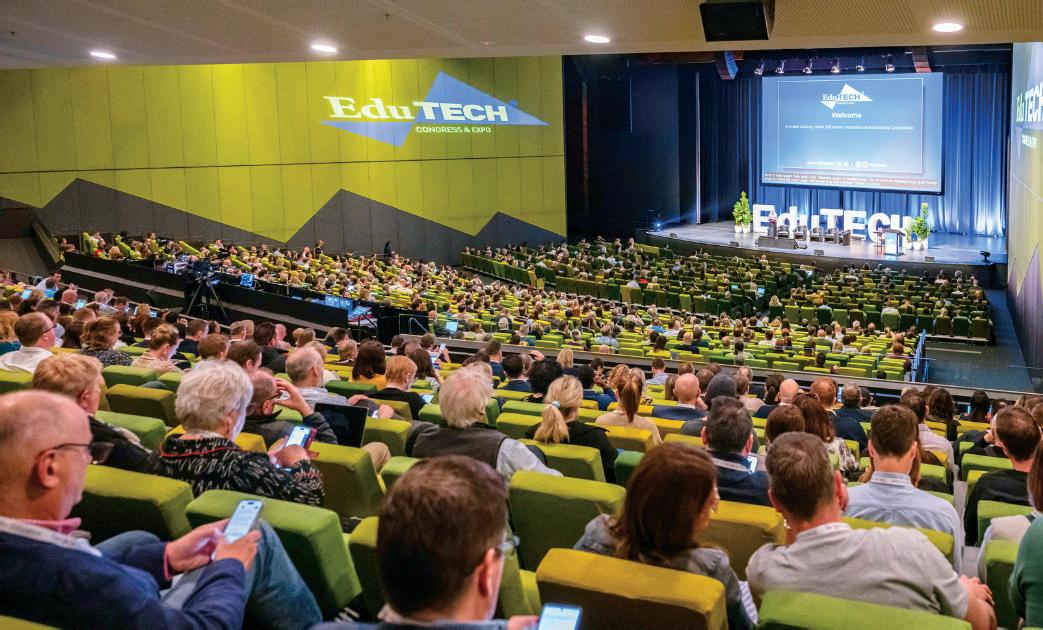
After a sold-out session in 2024, educator and founder of Khan Academy, Sal Khan will return as headliner.
With his groundbreaking work in AI-driven education, personalised learning, and mastery-based teaching, Sal is reshaping classrooms worldwide.
Other unmissable speakers include Rose Luckin from University College London, who will examine the accelerating AI adoption in learning environments, and the rush to implement technology without a comprehensive understanding; and AFL legend and Indigenous leader Adam Goodes, who will share powerful


MakMax Australia designs and constructs high-quality shade and weather protection structures for schools.
Our TensoCOLA creates durable, covered outdoor learning areas (COLAs) for year-round use, while the TensoSport canopy provides all-weather coverage for school sports courts. For playgrounds, walkways, assembly areas, and more, our Engineered Shade Structures o er tailored solutions that combine safety, style, and sun-smart design.
Built to meet the specific needs of each school, our tensile membrane structures are long-lasting, low-maintenance, and designed to support outdoor learning, play, and sport in all weather. With decades of experience across education and sport sectors, MakMax is your partner in smarter outdoor spaces. Maximise play, whatever the weather: Make It A MakMax.
insights on education, cultural inclusion, and empowering young Australians.
With a range of free and paid sessions, you can tailor your EDUtech experience to best suit your schedule and professional learning needs. The exhibition floor is free to all and will host more than 350 leading education technology players.
Eight free seminars will be held on the expo floor, covering diverse, cutt ing-edge topics that will inspire your teaching journey. Seminars will be facilitated by education thought leaders with insights into how to use technology to enhance student learning and teaching. Key topics will include active education, diff erentiated learning and inclusion, wellbeing, EdTECH innovation, and school operations. These free expo seminars are a must attend for educators looking to elevate their skills with some free professional development.
The paid EDUtech conference, running alongside the free expo, will feature more than 350 speakers who will discuss the latest trends, disruptors and technologies transforming the education industry. With a conference delegate pass,

EDUtech provides a hub for collaboration and conversation
you will gain access to plenary keynotes from leading experts, eight in-depth tracks exploring the latest trends in education, and wide-ranging networking opportunities with thousands of fellow educators. The eight paid conference tracks include leadership, connected schools, digital campuses and vocational futures.
The popular Innovation & Start-Up Alley will feature again this year, showcasing the best Australian start-ups in the education space. Be the first to discover new and growing products and trends, and enjoy the chance to be among the first to use these new innovations.
Along with exploring the latest innovations in education, EDUtech gives attendees unparallelled access to networking opportunities. EDUparty at the end of day one will be the perfect way to unwind while connecting with others in the industry. The free EDUtech app will help you keep track of your new connections.
To secure your tickets and browse the full programme of events, exhibitors and speakers, visit the Edutech Australia website.

By Gemma Easton , Editor
Artificial
Intelligence
(AI) is transforming the classroom experience in ways that save time, boost engagement, and personalise learning.
Teachers will never be replaced as the most important educators for our students. Incorporating AI technology into the classroom to support teachers, however, can make learning more dynamic, assessment more insightful, and lesson delivery more efficient.
AI is defined as any tool trained on massive datasets and capable of creating new content. For teachers, AI can significantly ease the administrative burden. Attendance tracking, grade aggregation, homework marking, and lesson planning and sharing can all be simplified with AI.
For students, immersive VR experiences, personalised learning units and intelligent tutoring systems can improve learning outcomes. Learning modules, for example, that don’t let a student progress to a new concept until they demonstrate proficiency in the current concept can help ensure key foundational ideas are understood by all students. Conversely, smart, AI-led learning modules can accelerate and extend students as necessary.
Of course, it’s important to balance the benefi ts of AI with the risks. Schools should prioritise student-teacher relationships, check for biases in content (consider who created the AI tool and what data it has been trained on), prioritise data privacy with clear policies on data storage, access and

deletion, and oversee student access to technology and the internet to ensure equity.
Emory Fierlinger, Founder of Kuraplan, said if you ask most teachers why they joined the profession, they’ll talk about wanting to help students learn, grow, and thrive. “What they won’t mention is writing lesson plans at 9pm, scouring the internet for resources, or doing admin tasks on a Sunday afternoon. And yet, these are the realities of the job today. That’s where I think AI has the power to make a real diff erence.
“Used thoughtfully, AI can take over some of the repetitive, time-consuming parts of a teacher’s week. This could include creating diff erentiated lesson plans, draft ing rubrics, summarising assessment data, or aligning a unit to the curriculum. It’s not doing the job for the teacher—it’s lightening the load, so they can focus on what really matters: the relationships, the creativity, the actual teaching.”
Mr Fierlinger cautioned that not all AI is created equal. “Tools like ChatGPT are incredibly capable, but they aren’t trained on the latest Australian Curriculum or individual
state standards. Ask them to align a lesson to specific outcomes, and they’ll often produce content that sounds
right, but isn’t. For teachers, that’s not just unhelpful—it can be really misleading. That’s why it’s so important to use AI tools that are built specifically for educators.
“Crucially, teacher-specific AI tools also respect teacher autonomy. They’re not there to dictate how a lesson should be taught, but they do provide a great starting point. The teacher remains the expert in the room, deciding what works best for their students. In that sense, good AI in education acts like a wellorganised teaching assistant: supportive, invisible when needed, and always responsive to the teacher’s lead.”



By Gemma Easton, Editor
Museums are rich sources of social, historical, and cultural knowledge. Inspiring curiosity and fostering enthusiasm across diverse subjects, museums are powerful sites for enriching education.
In an era where online sources dominate and separating fact from fiction, and real from a copy is difficult, museums provide a point of truth. Objects held in a museum’s collection can be confidently viewed and understood by students to be the real thing. Similarly, educators at museums can be trusted as sources of accurate, reliable information.
This means incorporating museum visits into your teaching can help students appreciate the value and importance of seeking out real-world sources, particularly primary sources, and not simply relying on the internet. Many museum educators devote their life to learning in a particular field. Exposing students to these professional learners can help students see firsthand what life-long learning means. In turn, this may spark their own lifelong learning journey.
Teachers also benefit from the experience and expertise of museum staff. With specialist staff able to work with students, teachers don’t need to be across the intricacies of all subject areas. While teachers have a broad understanding of all topics, experts like those on staff at museums can provide specialised, detailed knowledge in a particular field.
For some subject areas, you might find a dedicated museum. Other museums will have collections or installations that cover a range of curriculum areas. This means several different learning groups can visit the same museum, and then split into smaller groups for learning activities. Look out for visiting exhibits at your local museum that provide new learning opportunities.
Allowing students to explore the museum with little or no direction will give them some agency over their learning, as they make choices about which items or experiences to pursue. Encouraging students to form their own inquiry questions, then investigate and draw conclusions, can lead to strong learning outcomes. When learners can engage directly with their learning and take a proactive approach, they retain information more readily and can develop a longer-term interest in the topic.
Tactile learning—allowing students to touch, feel and

interact with objects—can help link neurological pathways and create better understanding, memory, and retention. It can also help students with short attention spans to focus. Museums can provide tactile learning experiences, with some items available for interactivity.
And while we might not like to talk about it, there’s no denying that being in a classroom day in, day out can get a bit boring. Sometimes, both students and teachers need some time away from the school grounds. Museums provide the excitement of a school excursion, combined with strong links to the curriculum.
As Melbourne was built on gold, so was the Old Treasury Building. Originally conceived as a safe and secure place for the government to store its precious metal reserves, the money it
generated fuelled the creation of many extraordinary buildings, including the Old Treasury. Students enter these original gold vaults to discover the journey people took from their home countries to Victoria and the hardships and rewards it held, including the Eureka Stockade.
While in the museum, students can venture from the past to the present and visit the Executive Council Chamber. Every Bill passed by the Victorian government has been given Royal Assent in this space, from the 1872 Education Act to the 1977 Equal Opportunity Act and more.
In addition to the Old Treasury Building’s one-hour paid programmes, extensively researched articles covering a multitude of topics are available free online. The team look forward to welcoming you and your students to experience one of Australia’s most beautiful and historic buildings.

By Angie Debnam, CEO, Kokoda Youth Foundation
The increased time spent indoors is a contributing factor to the rise in poor mental health.
This shift from green time to screen time is at its highest among teenagers. I lead an organisation founded on the belief that outdoor environments
provide some of the best opportunities for young people to learn and grow. Our flagship youth programmes incorporate outdoor, adventure-based learning as well as mentorship and community service. Our participant survey results2 show remarkable improvements in emotional wellbeing, confidence, and resilience.
According to Taking Charge of Your Health and Wellbeing1, spending time in green spaces reduces cortisol levels, lowers heart rate, and positively impacts mood and selfesteem. Even short periods outdoors can have immediate mental health benefits.
This is reflected in our data. Among the youth participants



surveyed, more than 75 percent reported improvements in their confidence and self-esteem. When young people discover what they’re capable of, they bring that determined mindset back into the classroom. Sixty percent of our participants and their parents observed better academic focus and school performance following our outdoor programmes.
Resilience creates a strong foundation for overall wellbeing and lifelong success. Learning how to face and overcome challenges in a positive way, is essential to helping young people flourish.
In our study, 80 percent reported increased resilience overall, citing that the 48km Kokoda Challenge hike was a key moment of personal transformation. They developed a level of resilience that can be hard to replicate indoors, and this improved their emotional fortitude even after the adventure was over.
and depression, replacing passive scrolling with active real-world engagement.
The impact doesn’t stop with the individual. Our data also shows that 65 percent of participants continued to engage in community service beyond their programme graduation. They felt a greater sense of purpose as meaningful contributors in the world around them. Through communitybased initiatives, young people learn empathy, responsibility, and teamwork—values that are integral to a fulfilling future.
The Kokoda Youth Foundation is a registered Australian charity that has been changing young lives since 2004.
Founded on the spirit of Kokoda and the values of courage, endurance, mateship and sacrifice, their flagship programs have helped hundreds of young people who may have been disengaged from their learning, or needing some guidance and direction. The Foundation’s programs incorporate outdoor
learning experiences and hiking challenges, as well as mentorship and community service. They include the Kokoda Challenge Youth Program (9 months), On the Right Track Program (6 months) and the Digital Detox Program (one week). All programs are o ered free of charge thanks to funds raised by the Kokoda Challenge event series. These team endurance events happen in four locations every year and participants fundraise for the Foundation before they embark on a gruelling hike of up to 96km, together with their team.
For more information please visit our websites: www.kokodayouthfoundation.com | www.kokodachallenge.com
Outdoor learning experiences give students the chance to unplug from social media, screens, and the pressure to perform. Instead, they are encouraged to plug into the moment, into nature, and into real, meaningful human connection. This digital disconnection is a crucial element in alleviating anxiety
Learning in an outdoor environment is no longer just a nice-to-have—it’s a vital component of a balanced, effective approach to learning. Our programmes are just one example of the transformative power of outdoor education in action and it’s exciting to see more organisations harnessing its many benefits. Our organisation will continue to champion this philosophy, encouraging the next generation to push their limits in the great outdoors, as they discover their true potential.
References
1 How Does Nature Impact Our Wellbeing? - Taking Charge of Your Health ...
2 From the Kokoda Youth Foundation’s anonymous participant surveys, conducted in 2024


By Sarah Davison, Industry Reporter
Upgrading outdoor sports surfaces is a powerful way for schools to support student health, wellbeing, and engagement. More than just a visual improvement, a well-executed upgrade creates safer, more dynamic environments that actively encourage participation across a wide range of sports.
Research shows that students who regularly engage in sport benefit from enhanced cognitive development, stronger social skills, increased attentiveness in class, and improved academic outcomes. Playing sport during childhood is also strongly linked with higher school completion rates—particularly among boys. Whether revitalising an ageing netball court or constructing a versatile new multi-sport facility, schools must carefully consider design, functionality, safety, and long-term usability. This feature explores the essential factors involved in
outdoor surface upgrades, offering practical insights to help schools create inclusive, high-performing sporting environments that inspire participation and school pride.
Balancing aesthetics with functionality is key when upgrading outdoor sports surfaces. Visually appealing, professionally marked courts can boost student enthusiasm and elevate the overall look of a campus.
Victoria Brockett from APT Asia Pacific said schools should decide what sports they are wanting to cater for, and what

space they have available or are wanting to upgrade. Then, they can look at what surfaces will be most suitable for catering to those sports.
“Schools may have a type of surface they would prefer based upon appearance or budget, however expert surface contractors will have the knowledge to inform schools about whether those surfaces are suitable for the chosen type of activity, safety requirements or for all-weather play.
“Some surfaces may also require additional base works or drainage which could impact cost.”
Additionally, surfaces are highly customisable, allowing schools

to express their identity through bold colours and graphics.
“There are a great variety of colours available in artificial turf, acrylic painted courts and soft-fall rubber. Schools can opt to have surfaces custom made to match their colours, usually at an additional cost,” Ms Brockett explained. “Schools can also get custom made emblems installed into their artificial turf, painted onto acrylic hard courts or integrated into soft-fall flooring.”
Each sport has specific surface requirements to support both performance and safety. Multi-use courts are popular for schools offering basketball, netball, tennis and general PE, as they can accommodate multiple sports with clearly defined line markings.
Rugby and hockey fields demand durable, high-impact surfaces with excellent drainage, while tennis and netball often require specific rebound and traction properties. Meanwhile, cricket facilities can be enhanced with synthetic wickets, offering year-round usability and low maintenance.
Ultimately, the right choice of sport surface depends on each school’s budget, climate, and specific sporting requirements.
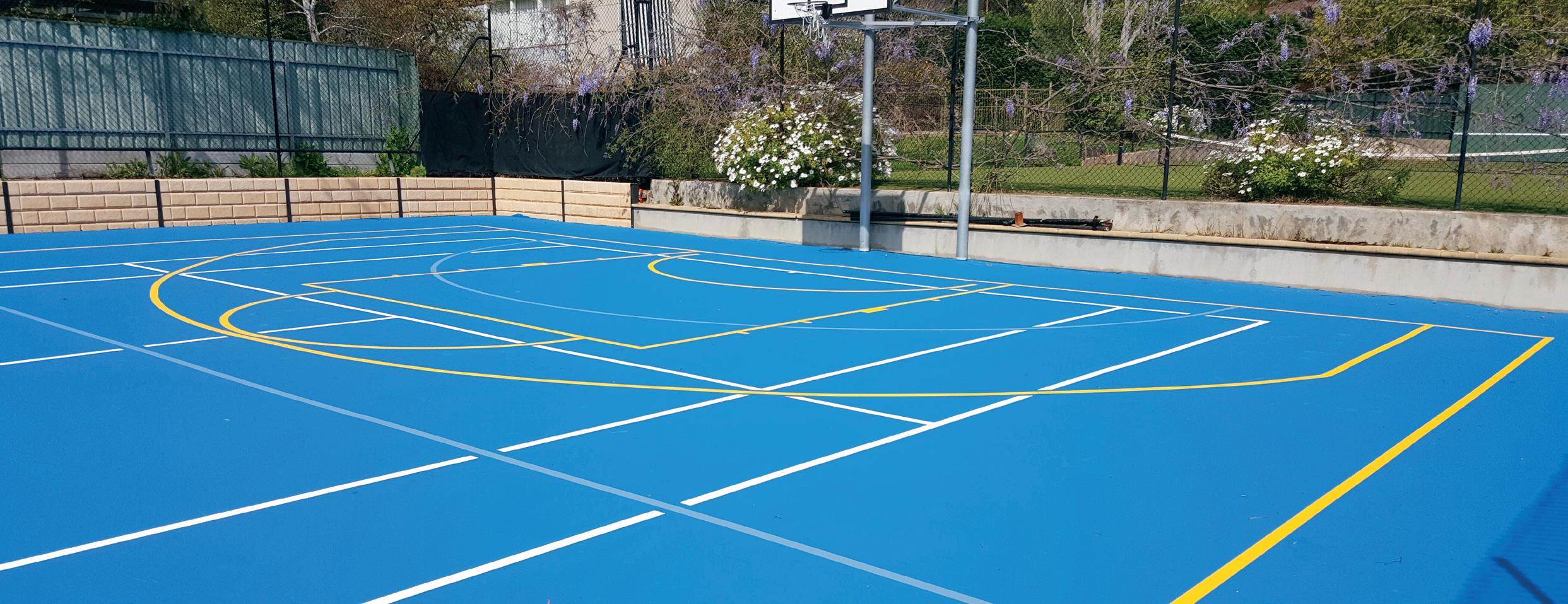
In space-constrained schools, the ability to host several sports on a single surface is a gamechanger. Multipurpose surfaces make it possible to run backto-back activities and adapt to seasonal sports without requiring multiple dedicated spaces. Courts can be line-marked for netball, basketball, tennis and more, with colour-coding helping to reduce confusion.
However, as Ms Brockett noted, it’s important to seek expert advice when developing multipurpose surfaces.
“Although multisport courts are incredibly functional, schools should be mindful of how many lines are used and what colours are chosen to ensure they are clear and easy for students to follow,” she explained.
When well-designed, these surfaces help maximise participation and streamline programming for teaching staff.
Ensuring student safety is essential when upgrading
sports surfaces. Regular inspections are critical to identify early signs of wear, drainage issues or surface damage.
Arun Kosh from Surfacing Contractors Australia said a well-maintained sports court plays a vital role in promoting student engagement, safety, and physical development.
“To ensure their sporting surfaces are both visually appealing and fully functional, schools should invest in regular maintenance either directly or through a qualified third party. This would include such things as surface cleaning, repainting court lines, and checking for wear or damage.
“A clean, clearly marked court encourages student participation and supports a variety of physical education activities.
“When sports surfaces show signs of wear—such as cracking, fading, or surface bubbling— schools should seek professional advice to assess the damage to determine whether repairs are feasible. Regular inspections and consultation with professional contractors can help schools

make informed decisions about court maintenance and upgrades,” Mr Kosh said.
“Many minor issues, like surface cracks or faded lines, can be addressed with resurfacing or patching. However, if the underlying foundation is compromised, a full replacement may be necessary. Prompt repairs not only extend the life of the court but also ensure ongoing safety for students.
“Ultimately, proactive care, proper material selection, and timely repairs are key to ensuring school sports surfaces remain safe, functional, and inviting for student use,” Mr Kosh said.
Quality outdoor facilities can have a profound impact on student participation. Fresh,
modern courts are inviting and can help engage students who may not previously have shown interest in sport. Well-planned designs and bright colours also boost school pride and team spirit, fostering a culture of inclusion and collaboration.
By investing in multipurpose or sport-specific spaces, schools give students more opportunities to be active, social, and confident—contributing to improved focus, behaviour, and overall wellbeing.
Such facilities can also extend value beyond school hours, supporting community sporting events and after-school programmes. In some instances, schools can hire their court or fields out to local sporting organisations. Profits from this can be reinvested in sporting programmes for students.

Peninsula Grammar has officially unveiled its new, state-of-the-art athletics and soccer facility—an ambitious project that reflects the school’s commitment to excellence in student development, health, and performance.
Designed for year-round use, the new precinct not only enhances Peninsula Grammar’s sporting capabilities but also supports broader educational outcomes by increasing participation and accessibility across the school community.
According to Executive Deputy Principal Stephen Church, the redevelopment was prompted by both practical needs and aspirational goals. “Our previous sports field was o en waterlogged and not usable throughout the year. It also wasn’t large enough to host full-sized games and training sessions,” he said. “We wanted to ensure our students had access to facilities that matched their potential.”
The upgraded facility features a sixlane athletics track with integrated long and high jump pits, alongside a full-size soccer pitch that meets FIFA standards. The design was guided by a vision to deliver an inclusive, high-performance space that can be used every day—rain, hail or shine.
For Principal Leandra Turner, space constraints initially posed a challenge. “The area available wasn’t regulation size, and we had existing buildings we didn’t want to lose,” she explained. “But through creative design and engineering, including substantial retaining walls, we were able to maximise the site footprint without compromising on

quality or function. Once we confirmed that, the excitement really took hold.”
The project took approximately two years from concept to completion, including a 12-month design and planning phase followed by construction. Polytan, an industry leader in sports surface construction, served as the head contractor and managed all works from site preparation to final surface installation.
Surfaces manufactured by APT in Melbourne, Australia were carefully selected for their durability, performance, and sustainability. The track is built using their Rekortan M system in vibrant Hertha Blue and Rainbow Blue, while the soccer pitch is surfaced with LigaTurf HB 250 synthetic grass. Both incorporate recycled and environmentally conscious materials, including SBR rubber derived from old tyres in the track system and an
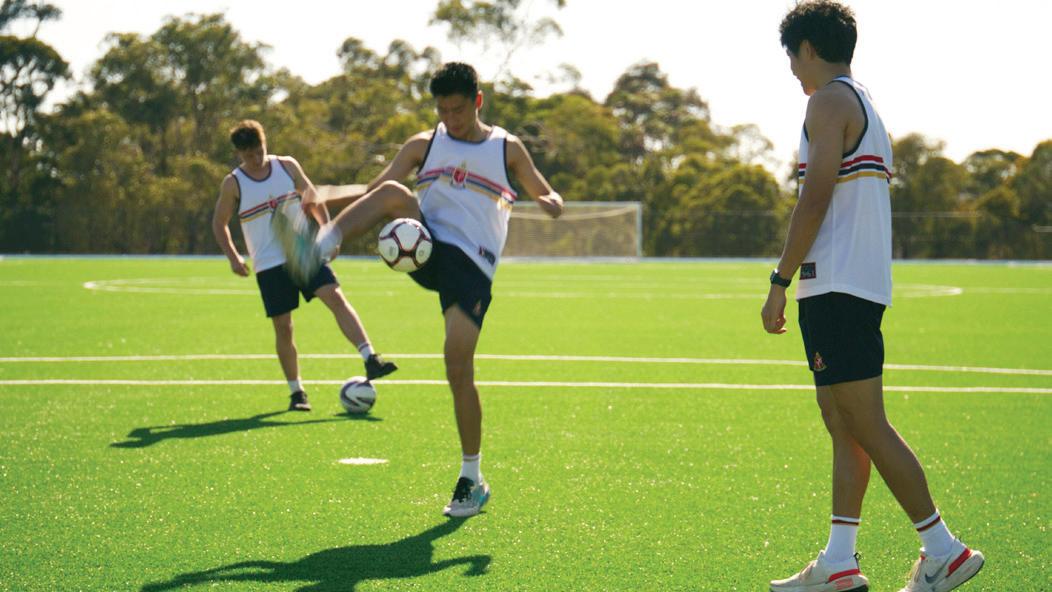

an innovative Brockfill turf infill made from organic wood-based material. Beneath the turf lies ProPlay, a shock pad created from repurposed foam.
Director of Sport Deb Gardner says these choices directly benefit students. “We now have a full 400m track with six lanes, four long jump pits, and two permanent high jump areas,” she said. “That means no more waiting in line or hauling equipment in and out. Students can train more e ciently and inclusively.”
The addition of high-powered lighting also means the facility is accessible beyond regular school hours. “We’ll run morning training sessions, a er-school programs, and even night matches,” Gardner added. “It’s a game-changer for how we schedule sport and physical education.”
Students aren’t the only ones looking
forward to using the new facility. Plans are underway to launch a “Wednesday Walk Club” for sta , encouraging school-wide wellbeing and reinforcing Peninsula Grammar’s vision of community-connected education.
The feedback from students has already been overwhelmingly positive. “They’re asking every day when they can get on the track,” said Gardner. “Those who have had a sneak preview describe it as ‘springy’ and say they feel like professional athletes. That sense of pride and motivation is exactly what we hoped to achieve.”
As the school prepares to o cially open the precinct, the facility stands as a powerful symbol of Peninsula Grammar’s future-focused approach— where infrastructure supports aspiration, and every student is empowered to pursue their personal best in sport and beyond.

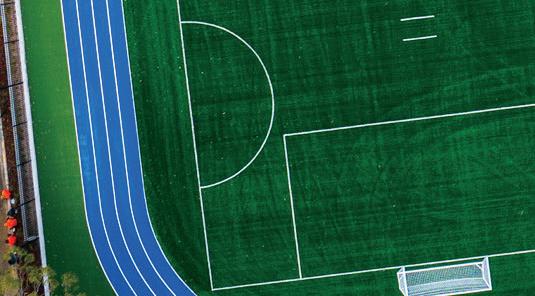









US Open, Tokyo Olympics, FIFA Headquarters, St Kevin’s College…



From the most prestigious sporting events to your l ocal school, APT manufactures and installs more artificial turfs, courts, playgrounds and tracks than any other business. Made in Austra lia from renewable resources, our artificial surfaces are backed by warranties of up to 15 years. 1800 652 548 I info@aptasiapacific.com.au I aptasiapacific.com.au
Your ultimate trough replacement
Cool Artwork

Aboriginal Art, civiq templates or create your own. Plus thank a donor, feature your school logo and values!
g






3 Fountains


sy Clean Shelf Bo pt


By Naomii Seah , Industry Reporter
Some schools find that expanding rolls are outpacing infrastructure capacity. Other schools are looking to bring their students closer to natural resources for new and engaging ways to teach and learn. In either case, a covered outdoor learning space is a great way to diversify classroom settings and expand utility on your campus.
Creating an outdoor learning space means school students and staff can get more outside time, which has been proven to benefit both students and teachers. With a covered area, the harsh Australian sun, wind and rain won’t stop school communities from getting some fresh air, reawakening students who may be drifting off in a stuffy inside setting.
Shane Scully from Scully Outdoor Designs Australia said that covered outdoor learning spaces can improve student engagement.
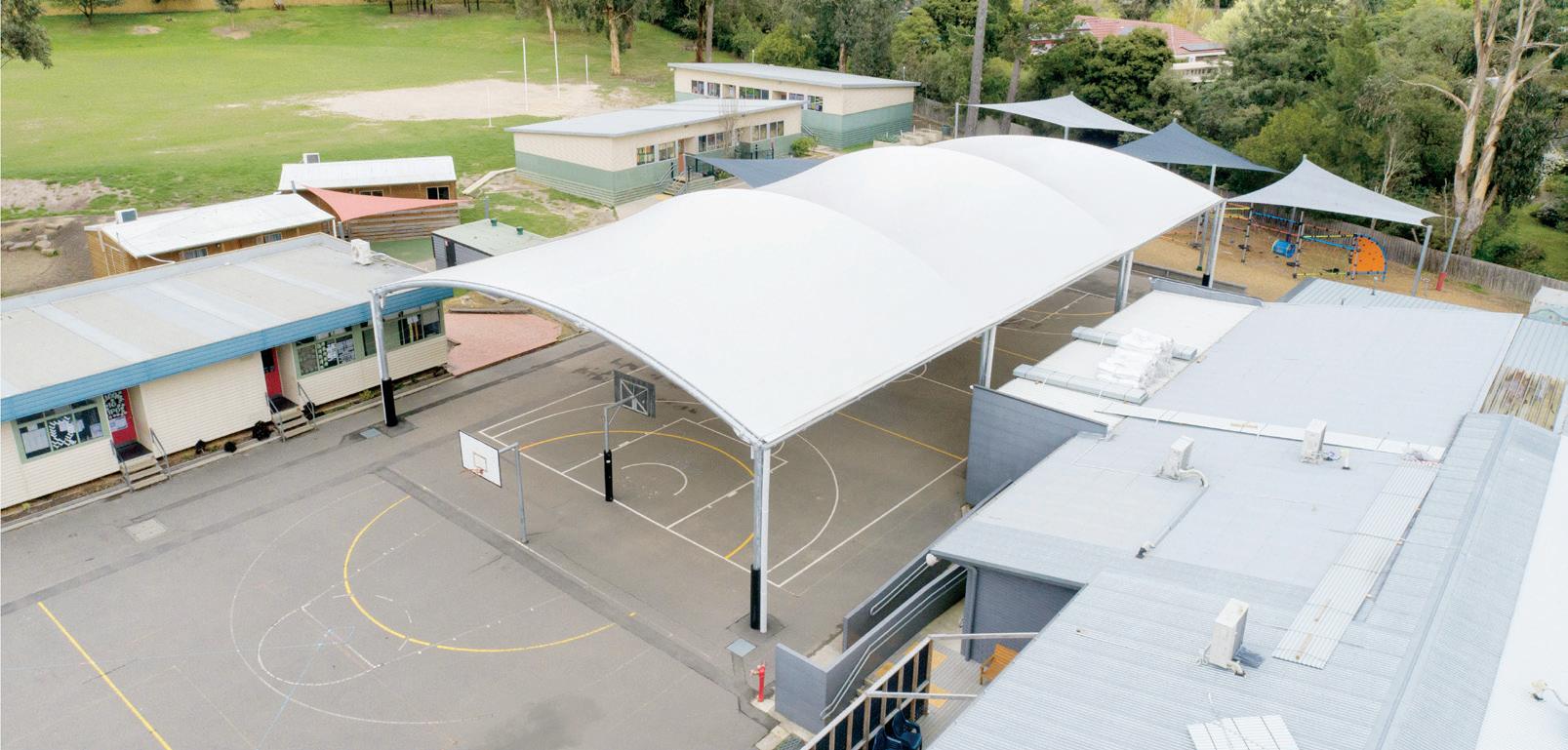
“Sheltered outdoor areas add value for schools as they make learning more engaging and relevant, inspiring creativity and imagination.”
Mr Scully noted improved access to the outdoors may even mean schools see a reduction in behavioural problems, and improved attendance.
Covered outdoor learning spaces enhance the school environment by bringing staff and students closer to the outdoors, rain or shine, which may enhance wellbeing. Adding a covered outdoor space may encourage students and staff to spend more time outside, offering opportunities to get away from screens and textbooks. A brief nature break has been shown to relax

busy and stressed minds, and even promote boosts in creativity. Being in nature can also decrease feelings of depression and anxiety.
Lindsay Stead, from Astra Street Furniture, said: “Spending time in natural environments is just as crucial for children’s development as learning to read and write—so why not bring learning outdoors?
“Outdoor classrooms provide an engaging way to support student development while promoting wellbeing. Fresh air, natural light, and open spaces have been shown to reduce stress, improve mood, enhance eyesight, and encourage physical activity—all of which contribute to better health and learning outcomes.”
When designing an outdoor learning area, schools should consider various factors including capacity, intended use and existing school features.
In addition to functioning as outdoor learning spaces, some covered outdoor areas can be multiuse, going from break areas to art spaces or even school weather stations.
Other uses of covered outdoor learning spaces could include housing vegetable patches, sensory gardens, or play structures and sandpits. These features could offer year-round transdisciplinary outdoor learning, as well as new ways to play and unlock children’s creativity.


With a sheltered area, students can access experiences they may otherwise miss out on, like tending to winter vegetables, or staging an outdoor production.
Diane Bramble from MakMax Australia notes that when designing a covered outdoor area, schools should first consider an outdoor space’s intended use.
“Will it be a fully weatherproof area suitable for all-weather teaching, outdoor assemblies, and performances, or is a shaded space for play and relaxation the primary goal? A waterproof structure provides greater flexibility for multi-use learning spaces, ensuring students and staff can utilise the area year-round.
“Schools should also consider the long-term value of their investment. While shade sails may offer a lower initial cost, engineered shade structures, such as tensile membrane canopies or modular shade structures, are designed for durability and longevity. An engineered structure can last for decades, reducing ongoing maintenance costs and providing a permanent architectural feature that enhances the school’s environment.”
Mr Stead agrees that schools should think about the intended usage of their outdoor spaces as a first port-of-call. He said questions the school should ask include: “How many students and classes might share the space at once? Will it be multiuse, that is, a social area during lunchbreaks, or accessible to the wider community after hours? Is the space wheelchair accessible, and does it have appropriate circulation?
“Schools should also think about integrating the covered outdoor space with existing school architecture, and whether the degree of weather protection is fit for use,” Mr Stead said.
Schools designing covered outdoor learning areas may want to consider existing features of the campus. Placing a covered outdoor area beside a significant tree, other natural features or an existing sports field may offer school communities new ways to interact with the grounds, boosting wellbeing or community spirit.
The natural world is rife with learning opportunities, and these are often underutilised in schools. What flora and fauna exist on school grounds, for example, and how can these resources be turned into learning opportunities for students?
Student-led investigations into the natural world become more accessible with outdoor learning areas, and help to foster students’ curiosity about the environment. Making the outdoors more
accessible also encourages students to be engaged with the world around them.
Outdoor learning spaces have endless potential, and schools often already have suitable spaces, such as courtyards between buildings or a common building that could benefit from an outdoor extension, or an open space that would become more functional with the addition of a covered canopy.
Similar to choosing a shade structure, the area, intended use and local weather patterns will influence what types of furniture would be suitable for covered outdoor areas. Outdoor furniture for such spaces should be durable, weather resistant and easy to clean.
Mr Stead said outdoor classrooms need ageappropriate and durable furniture that enhances learning and comfort.
“Schools may wish to consider four-sided and two-sided picnic settings for collaborative learning, curved and angled benches to create engaging and flexible seating

layouts, and wheelchair accessible furniture to ensure inclusivity for all students.”
Universal design is also crucial for upholding the rights of people with disabilities. Around one in five, or 20 percent of Australians have a disability. People with a disability often face barriers to work, study, and taking part in everyday life. This includes school settings where outdoor areas can be inaccessible to people with disabilities, especially those with mobility challenges.
Traditional outdoor areas can have uneven and unsuitable terrain such as grass and bark, which can mean people with disabilities can have difficulty accessing outdoor spaces. This is especially troubling when considering outdoor spaces have been shown to improve wellbeing, and almost a third of adults with disability experience high or very high levels of psychological distress. To ensure all outdoor spaces are accessible and inclusive, schools should think about the existing outdoor spaces on campus—are they currently welcoming to all staff and students? A new covered outdoor area could significantly improve outdoor access for people with disabilities on campus, ensuring your school better upholds their rights.
Adding new spaces like outdoor learning areas is also a chance to develop the school culture and values. Involving students and staff in the design of a new space creates community and a sense of shared purpose. Shade structures are often highly customisable, with size and canopy colours available to suit individual schools.
Finally, Mr Scully suggests schools should design the space to integrate with the surrounding school environment, with “ageappropriate settings.
“Schools should also collaborate with both teachers and students to select either a natural colour scheme or brightly coloured outdoor furniture to enhance surroundings.”
Outdoor
is a leading supplier of quality and innovative outdoor products.
Core to our business is a large range of Outdoor Furniture and shade options including Shade Sails, Shelters and Commercial Umbrellas. We also o er Synthetic Grass and other ground cover options and Landscaping services. We provide a free design service for playground upgrades featuring outdoor learning areas and a range of playground options for all ages. We are experts in designing and creating outdoor spaces that excel in both form and function.
Our extensive range of quality made low maintenance designs are manufactured with Steel or Aluminium frames with a choice of Recycled Plastic Wood, Aluminium or Timber Slats. From contemporary to heritage ranges of Street & Park furniture, we can create unique areas for your project, and can plan and construct to suit your requirements.
Shade Sails, Shelters and Commercial Grade Heavy Duty Umbrellas
O er the ultimate in design flexibility and represent the most lightweight, cost-e ective option for outdoor shelter.
We o er a variety roof types and materials for our shelter range. The Triax System is adaptable and an alternative option for waterproof shade.
Our Commercial Grade Heavy Duty Umbrellas are superior in design, construction and materials and

combine to produce a commercial umbrella able to withstand the most demanding Australian conditions.
Our company mo o of “Take the Classroom Outside” has come about a er our research into the benefits of Outdoor Learning for students of all ages. It makes learning more engaging and relevant, inspires creativity and imagination.
Students develop learning through experimentation with almost limitless resources, and it can reduce behaviour problems and improve a endance.
SOLA’s Creating Quiet Spaces for Sta . Sta Outdoor Lunch Area’s can provide an ideal outdoor alternative to sta rooms.
SOLA’s are perfect for pupil free time, lunch time and outdoor sta meetings.
An alternative Outdoor Classroom for students to engage in learning in a relaxed open space. It encourages the connection to Aboriginal Culture and Heritage and promotes the ideals of:
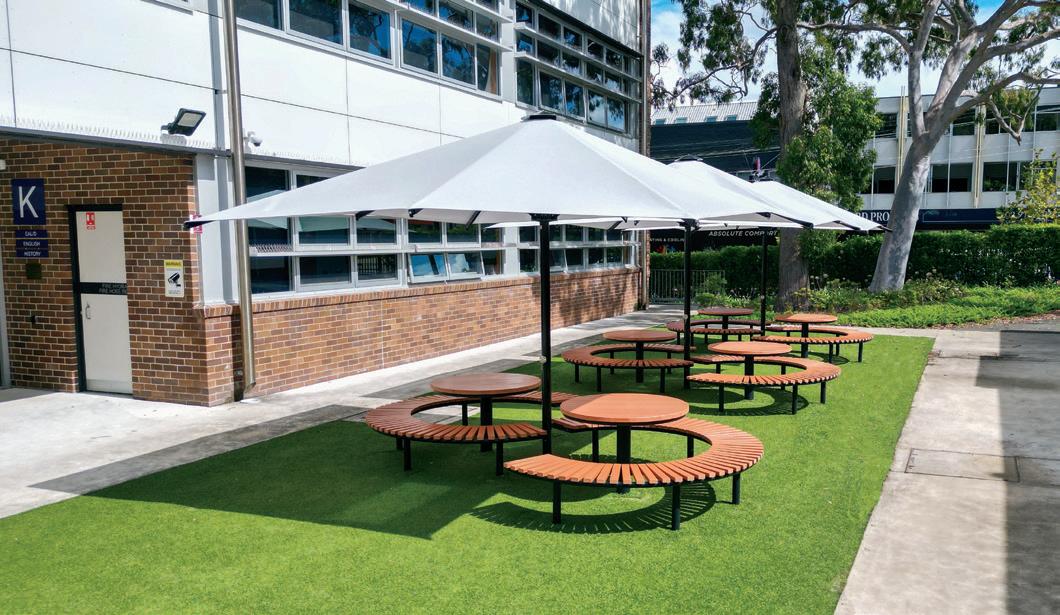
• Listening and Talking
• Teamwork and Unity
• Trust and Tenderness
• Belonging and Story telling.
This primary school concept is designed for encouraging young students to be physically active in a fun and natural environment within school grounds. It is used during school lunch and recess, as well as assisting “Before and A er School” carers by keeping kids in care, healthy and moving.
Our Learning and Performance Spaces o er an innovative and ‘sustainable choice’ area incorporating recycled plastiwood decking, seating, performance platforms, food gardens, as well as play areas featuring art installations and our recently added “Percussion Play” range of musical instruments made for the outdoors.
Percussion Play outdoor musical instruments o er cognitive, emotional, physical and inclusive play opportunities
for everyone, everywhere. There is something special about music that crosses barriers and encourages closeness regardless of age, race, religion and background. Add in the therapeutic environment of nature and the great outdoors, and there are few things more enjoyable than musical play. We strongly believe that outdoor musical instruments tick all the boxes, o ering cognitive, emotional and physical play opportunities for everyone, everywhere.
Scully Outdoor Designs can arrange an extensive list of landscaping services, including Synthetic Grass, Timber Decks, and general Playground upgrades.
The perfect solution for:
• Playgrounds & Passive Areas.
• Sports Fields, Courts, and Cricket Pitches.
• Covering existing Asphalt and Concrete, including stairs.
Australian Made Synthetic Grass assuring the highest quality.
Best suited for:
• Playgrounds that require Impact A enuation
• Outdoor play areas
• Areas that require a hard-wearing low maintenance surface
Composite Decking has many benefits. No ongoing maintenance using environmentally recycled materials.
For more information contact: Scully Outdoor Designs 02 9531 4166 email: info@scully.net.au or visit our website at www.scully.net.au


By Gemma Easton , Editor
A good education is about more than the quality of teaching—it’s about making children feel respected, safe and valued. This extends beyond the classroom, and students should feel comfortable and cared for no matter what area of the school they are in.
School washrooms are no exception. Busy, high-use areas that are usually not directly supervised, washrooms require extra attention to keep them fi t for student use.
A 2021 study of school toilet sanitation and student usage involved parents and children from India, Poland, South Africa and the United Kingdom. The study found that nine in 10 children had experienced issues with their school toilets some or all of the time, ranging from lack of handwashing facilities, missing and broken items,


neglected facilities, cleanliness, and a lack of privacy and safety.
One in 10 children indicated they avoid eating and drinking at school, so they don’t need to use the toilet. In the worst cases, eight percent of students reported having wet or soiled themselves because they did not want to use the school toilets. One in 10 children also said they were missing school to avoid using poorly cleaned and maintained school toilets.
Upgrading school washroom facilities could have a significant impact on student comfort, as well as physical and mental health. Campus aesthetics, and health and safety will also be improved by ensuring washrooms are clean, safe and well presented.
Fitt ing out a new space with the latest fi xtures and fi tt ings is always exciting. In washrooms though, there are considerations beyond aesthetics.
All items selected for your washroom should be durable and easy to clean. To make cleaning easy, avoid intricate tile details or toilets or sinks with unnecessary crevasses. Doors and cubicle partitions with antimicrobial properties will help stop the spread of infection.
Ensure items including toilets and sinks are the appropriate size, and that amenities like cubicle locks and hand dryers or paper towels are at an accessible height. If students of varying ages will use the facilities, it’s best to favour older students.
Anitha Roy from Solaris Paper said when selecting paper towel dispensers for washrooms, schools should prioritise durability, ease of use and hygiene. “Touchless models enhance sanitation by minimising contact, while a design that accommodates standard paper towel packs ensures cost-eff ectiveness and reduces maintenance. Ultimately, investing in reliable dispensers contributes to a cleaner, more efficient school environment.”
Students with mobility considerations must be catered for, as well as any students with hearing or vision impairments. To allow all students easy access to the washroom, wide, even paths should surround the building. Covered walkways will mean students can access washrooms in all weather.
To align with your school’s sustainability targets, look for toilets that are water efficient. Taps as well can be water saving, and sensor activated taps will ensure water isn’t left running.
By Sarah Davison, Industry Reporter
From investing in new waste management systems to incorporating recycling into the curriculum through excursions and onsite activities, many schools are taking proactive steps to reduce their environmental impact while also educating the next generation of eco-conscious citizens.
For schools looking to reevaluate their waste management systems, one of the most effective tools is conducting a waste audit. According to Astra Street Furniture Business Development Manager Lindsay Stead, waste audits are a “critical tool” for schools in understanding their waste generation patterns.
“By conducting a waste audit, schools can track the types and volumes of waste they produce, which helps identify problem areas. For example, if a school finds that a significant portion of their waste is coming from food scraps or paper products, this insight can drive targeted actions like reducing packaging waste or introducing composting programmes,”
Mr Stead explained.
“Waste audits also help schools set realistic goals for waste reduction and tailor their strategies accordingly, whether it’s reducing single-use plastics, encouraging recycling, or using more sustainable materials in classrooms and cafeterias. The information gathered from audits allows for the creation of more sustainable and effective waste management systems that can reduce overall waste while also fostering a culture of environmental responsibility among students and staff.”


Once schools understand their waste patterns, the next step is to implement a bin system that supports effective waste separation and reduces contamination. Getting this right is crucial—and it starts with thoughtful planning.
Clear labelling and signage: Bins should be clearly marked with easy-to-understand labels that specify what can and cannot be placed inside. Using colour-coded bins (e.g., green for recyclables, blue for paper, red for general waste) helps ensure proper disposal.
Convenient placement: Bins should be located in areas with high foot traffic, such as near canteens, classrooms, and playgrounds, to encourage use and prevent waste from being discarded inappropriately.
Staff training and student education: Educating staff and students about the importance of recycling and the specific items that go into each bin can minimise contamination.
Frequent emptying and maintenance: Bins need to be emptied regularly to prevent overflow and contamination.
Appropriate bin size: The size of the bins should be appropriate for the school’s waste output. Too many small bins can lead to overcrowding, while too few large bins may cause inefficient waste sorting. Junior schools should consider lower height bins up to 120L size so that students can reach them more easily.
However, even with the right systems in place, schools often still encounter challenges in improving their waste practices.
“Some of the biggest challenges schools face include a lack of awareness and engagement,” Mr Stead explained.
“Students, teachers, and staff may not fully understand the importance of waste management or how to properly sort waste. To overcome this, schools can implement regular educational campaigns, such as classroom lessons, assembly talks, and engaging activities that emphasise the importance of recycling and sustainability. Starting with junior year groups helps to create ongoing student engagement.”
Another issue is contamination in recycling bins, with non-recyclable items being incorrectly placed in recycling bins.
“To tackle this, schools can ensure that their bin systems are clearly labelled and place emphasis on education around the correct use of each bin. Also, having staff or student volunteers monitor and correct improper disposal can be effective,” Mr Stead said.
“Time and budget constraints are a common challenge,” Mr Stead added. “With limited time and budget, schools may struggle to implement and maintain waste management systems. Local Australian manufacturers with short lead times can help by providing cost-effective, durable, and easy-to-maintain waste management solutions designed for schools, offering tailored options that make it easier to stay on top of waste disposal without straining resources.
“By addressing these challenges, schools can create a more effective waste management system that not only reduces waste but also fosters a culture of sustainability among students and staff.”
From understanding waste patterns to investing in smart infrastructure and education, schools are in an ideal position to lead by example. By embracing practical solutions and empowering students, schools are not just managing waste, they’re shaping a more sustainable future.























































































































































































































































Bound rubber mulch offers several advantages over conventional loose laid wood mulch in school gardens and amenity areas. Made from recycled rubber bound with polyurethane to form a monolithic poured in place solution, it is highly durable, and does not decompose, reducing the need for frequent replacement. Unlike wood mulch, it resists mold and pests, while minimizing weed growth, promoting a cleaner, safer environment for children. Rubber mulch retains its color longer and does not fade easily, maintaining a neat appearance year-round. Additionally, it has a high porosity rate making it ideal around trees. Overall, it’s a low-maintenance, long-lasting, child-friendly option for school landscaping providing cost of ownership benefits.
C Surfacing Contractors Australia P 0432 497 920 E ian@surfcon.com.au W www.surfcon.com.au

Owning your own portable stage for school events has never been easier! Transtage portable stages are designed with schools in mind— lightweight, robust, and easy to set up without any special tools or training. Whether it’s a school assembly, performance, or guest speaker presentation, our modular stage systems offer the flexibility to configure any size or shape to suit your space. All decks pack down compactly for easy storage and transport. With Transtage, you can elevate your event wherever and whenever needed. Invest in a long-term solution that saves time, effort, and cost. Enquire today for an obligation-free quote!
C Transtage P 1300 712 066
E info@transtage.com.au W www.transtage.com.au

Transform your school’s outdoor spaces with Astra’s Spencer Picnic Range — a modern, low-maintenance solution ideal for playgrounds, lunch areas, and outdoor learning zones. Built for comfort and durability, these settings are made from weather-resistant materials and are designed to withstand daily student use. Available in a range of vibrant colours and configurations to suit your school’s style and space. Proudly held in stock for immediate delivery with fast turnaround times.
C Astra Street Furniture P 1300 889 821
E sales@astrastreetfurniture.com.au W astrastreetfurniture.com.au
